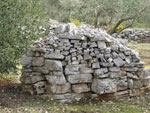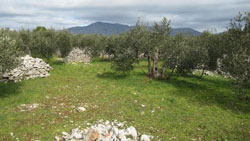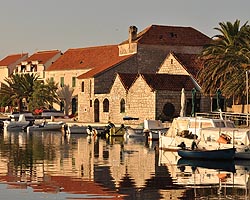Island of Hvar, Sućuraj - Agriculture

 Like in many other places on Croatian islands and coastline, people in Sućuraj on the island of Hvar engage in Mediterranean agriculture. Working in the olive groves and vinyards are the most important agricultural activities.
Like in many other places on Croatian islands and coastline, people in Sućuraj on the island of Hvar engage in Mediterranean agriculture. Working in the olive groves and vinyards are the most important agricultural activities.
In past times the importance of agriculture was far greater for people's lives than it is now. Except a fertile field just on the edge of the town, the land around Sućuraj is craggy so people had to manually remove large amounts of stone from the ground to gain arable land. That formed many long drywalls called "gomile". In between these drywalls laid parts of land that could then be cultivated, called "laz". On slippery grounds these drywalls also served as protection from erosion. One owner frequently had more than one of those parts of arable land and the division of land used to,  and still does, consider these strips of land which are often irregular in shape. Because the land was so scarce and the stone so abundant, people used wider drywalls as pathways. And often the stones were assembled in shapes of rollers called "badnji" some of which are little pieces of art. Stone was used to build
and still does, consider these strips of land which are often irregular in shape. Because the land was so scarce and the stone so abundant, people used wider drywalls as pathways. And often the stones were assembled in shapes of rollers called "badnji" some of which are little pieces of art. Stone was used to build  cottages with roofs made of stone plates. Most of these houses are standard shape, with only a small portion of them shaped like cones. The cone shape of building originates from the time of the Illyrians and a house built like this in called "torijun" in Sućuraj. A lot of the drywalls and stone houses are preserved to this day, but most of them can't be seen on first glance because the forest has take over what was once arable land.
cottages with roofs made of stone plates. Most of these houses are standard shape, with only a small portion of them shaped like cones. The cone shape of building originates from the time of the Illyrians and a house built like this in called "torijun" in Sućuraj. A lot of the drywalls and stone houses are preserved to this day, but most of them can't be seen on first glance because the forest has take over what was once arable land.
 Although more land was cultivated in the past, today many of the olive groves are being cultivated and also some of the vinyards as well. This means that agriculture is an important economical activity in Sućuraj today. During the 1990's old and abandoned olive groves started to regenerate. There is an old saying in Sućuraj, the olive tree is like a mother, she waits patiently for her children to come back to her. Olive trees can live for hundreds of years.
Although more land was cultivated in the past, today many of the olive groves are being cultivated and also some of the vinyards as well. This means that agriculture is an important economical activity in Sućuraj today. During the 1990's old and abandoned olive groves started to regenerate. There is an old saying in Sućuraj, the olive tree is like a mother, she waits patiently for her children to come back to her. Olive trees can live for hundreds of years.  When an olive grove is neglected and the forest takes over, the olive tree still lives even though it seems like the forest has won. After regeneration of the tree it doesn't take long for the crop to grow as is the case with new trees. If ,however the tree does not survive, one can gain large amounts of highly valuable firewood. Another old saying says: "Olive three is a blessed tree, it burns dry and wet".
When an olive grove is neglected and the forest takes over, the olive tree still lives even though it seems like the forest has won. After regeneration of the tree it doesn't take long for the crop to grow as is the case with new trees. If ,however the tree does not survive, one can gain large amounts of highly valuable firewood. Another old saying says: "Olive three is a blessed tree, it burns dry and wet".
 Most common variety of olive trees in Sućuraj, as well as in whole of Dalmatia, is oblica. It is known to be relatively unreliable (large oscillations in the amount of crop from year to year) but it gives supreme olive oil in return. The olive harvest begins usually in early November and lasts through December. Most of the people from Sućuraj are busy in their olive groves so it is a rare occasion to run into someone in the town during this period. Most of the crop is processed in mills in Sućuraj and Poljica (a village on the island of Hvar, 37 km west from Sućuraj). Olive processing in the Sućuraj's mills is done by modern technology of cold process of centrifuge.
Most common variety of olive trees in Sućuraj, as well as in whole of Dalmatia, is oblica. It is known to be relatively unreliable (large oscillations in the amount of crop from year to year) but it gives supreme olive oil in return. The olive harvest begins usually in early November and lasts through December. Most of the people from Sućuraj are busy in their olive groves so it is a rare occasion to run into someone in the town during this period. Most of the crop is processed in mills in Sućuraj and Poljica (a village on the island of Hvar, 37 km west from Sućuraj). Olive processing in the Sućuraj's mills is done by modern technology of cold process of centrifuge.  The old mill that was once operational in Sućuraj used traditional processing "under the press" that is grained olives were pushed by hydraulic transmission until the oil poured out. The mill in Poljica still uses this technology so some of the local people use that mill to make their olive oil. There are supporters for both of these techniques. The truth is that the oil from Sućuraj is of very high quality no matter the technology used to make it.
The old mill that was once operational in Sućuraj used traditional processing "under the press" that is grained olives were pushed by hydraulic transmission until the oil poured out. The mill in Poljica still uses this technology so some of the local people use that mill to make their olive oil. There are supporters for both of these techniques. The truth is that the oil from Sućuraj is of very high quality no matter the technology used to make it.

 Old vineyards are rare and people mostly cultivate small vine groves for their own needs. Despite this there is no shortage of domestic wine because those families who don't have enough of their own grapes buy them from other places on the island of Hvar or on the mainland to make their own wine the traditional way. On the ground floor of most traditional Dalmatian houses (and even some new ones) is a special section called the "konoba".This special space is used to store olive oil, wine, domestic produce, farming and fishing tools, fishing nets....It is also used to make wine the traditional way.
Old vineyards are rare and people mostly cultivate small vine groves for their own needs. Despite this there is no shortage of domestic wine because those families who don't have enough of their own grapes buy them from other places on the island of Hvar or on the mainland to make their own wine the traditional way. On the ground floor of most traditional Dalmatian houses (and even some new ones) is a special section called the "konoba".This special space is used to store olive oil, wine, domestic produce, farming and fishing tools, fishing nets....It is also used to make wine the traditional way.  The only serious winemaker in the town is "Vujnović Celler" (Podrum Vujnović), who for years now produces supreme, quality and table wines: red Ivan Dolac, Plame and Sućuraj; white Prč and Oka Vina and rosé Opol. In 2014 Vujnović family planted a new, 4 hectare large, vine grove above Mrtnovik bay, with 24 000 vines of Prč, Pošip and Plavac mali vine varieties. Prč is variety of white grapes indigenous to Sućuraj and was drunk on the court of the emperor Franz Joseph.
The only serious winemaker in the town is "Vujnović Celler" (Podrum Vujnović), who for years now produces supreme, quality and table wines: red Ivan Dolac, Plame and Sućuraj; white Prč and Oka Vina and rosé Opol. In 2014 Vujnović family planted a new, 4 hectare large, vine grove above Mrtnovik bay, with 24 000 vines of Prč, Pošip and Plavac mali vine varieties. Prč is variety of white grapes indigenous to Sućuraj and was drunk on the court of the emperor Franz Joseph.
 Besides olive oil and wine, there are many kinds of traditional strong alcoholic beverages made in Sućuraj. These beverages, called "rakija", are made by distillation from grapes and in most cases with added herbs or fruits to give them a unique and often sweeter flavour. Other traditional produce include figs, carob and honey. The figs ripen during August and are eaten fresh or dried. Dry figs are a delicacy that everyone should try.
Besides olive oil and wine, there are many kinds of traditional strong alcoholic beverages made in Sućuraj. These beverages, called "rakija", are made by distillation from grapes and in most cases with added herbs or fruits to give them a unique and often sweeter flavour. Other traditional produce include figs, carob and honey. The figs ripen during August and are eaten fresh or dried. Dry figs are a delicacy that everyone should try.  A few people in the village keep bees and thanks to many essential herbs that grow near the village bees make quality honey, of which sage honey is most popular. People in the village for their own needs also grow variety of crops such as: lemons, oranges, tangerines, pomegranates, almonds, potatoes, tomatoes, cucumbers, peas, broad bean, green beans, onions, garlic, lettuce, cabbage, Dalmatian cabbage, silver beet etc.
A few people in the village keep bees and thanks to many essential herbs that grow near the village bees make quality honey, of which sage honey is most popular. People in the village for their own needs also grow variety of crops such as: lemons, oranges, tangerines, pomegranates, almonds, potatoes, tomatoes, cucumbers, peas, broad bean, green beans, onions, garlic, lettuce, cabbage, Dalmatian cabbage, silver beet etc.








 English
English  Hrvatski
Hrvatski  Deutsch
Deutsch  Italiano
Italiano  Polski
Polski  Čeština
Čeština  Slovenčina
Slovenčina  Slovenščina
Slovenščina 









